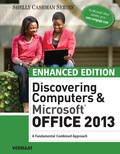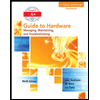
EBK ENHANCED DISCOVERING COMPUTERS & MI
1st Edition
ISBN: 8220100606922
Author: Vermaat
Publisher: YUZU
expand_more
expand_more
format_list_bulleted
Concept explainers
Question
Chapter 6, Problem 20SG
Program Plan Intro
Random Access Memory (RAM):
- It is a part of computer’s main memory, which is directly accessible by CPU.
- It is also known as main memory.
- It contains memory chips which are used to read from and written to processor and other devices.
- The contents of RAM may alter when the processor selects and performs a program though the given program is in RAM.
- It is volatile type of memory.
- Because, once the power is separated from the computer, user loses their content.
- Therefore, user needs to save data, instructions and other information for future needs.
Explanation of Solution
Types of RAM:
There are two types of RAM such as Dynamic RAM (DRAM) and Static RAM (SRAM).
- DRAM:
- DRAM chips contain higher access time.
- DRAM chips are cheap.
- Size of DRAM chips is large.
- Speed of DRAM chips is slow.
- DRAM provides reduced power usage because the data is stored in the capacitor...
Expert Solution & Answer
Trending nowThis is a popular solution!

Students have asked these similar questions
A manipulator is identified by the following table of parameters and variables:a. Obtain the transformation matrices between adjacent coordinate frames and calculate the global transformation matrix.
Which tool takes the 2 provided input datasets and produces the following output dataset?
Input 1:
Record
First
Last
Output:
1 Enzo
Cordova
Record
2 Maggie
Freelund
Input 2:
Record
Frist
Last
MI
?
First
1 Enzo
Last
MI
Cordova
[Null]
2 Maggie
Freelund
[Null]
3 Jason
Wayans
T.
4 Ruby
Landry
[Null]
1 Jason
Wayans
T.
5 Devonn
Unger
[Null]
2 Ruby
Landry
[Null]
6 Bradley
Freelund
[Null]
3 Devonn
Unger
[Null]
4 Bradley
Freelund
[Null]
OA. Append Fields
O B. Union
OC. Join
OD. Find Replace
Clear selection
What are the similarities and differences between massively parallel processing systems and grid computing. with references
Chapter 6 Solutions
EBK ENHANCED DISCOVERING COMPUTERS & MI
Ch. 6 - Prob. 1SGCh. 6 - Prob. 2SGCh. 6 - Prob. 3SGCh. 6 - Prob. 4SGCh. 6 - Prob. 5SGCh. 6 - Prob. 6SGCh. 6 - Prob. 7SGCh. 6 - Prob. 8SGCh. 6 - Prob. 9SGCh. 6 - Prob. 10SG
Ch. 6 - Prob. 11SGCh. 6 - Prob. 12SGCh. 6 - Prob. 13SGCh. 6 - Prob. 14SGCh. 6 - Prob. 15SGCh. 6 - Prob. 16SGCh. 6 - Prob. 17SGCh. 6 - Prob. 18SGCh. 6 - Prob. 19SGCh. 6 - Prob. 20SGCh. 6 - Prob. 21SGCh. 6 - Prob. 22SGCh. 6 - Prob. 23SGCh. 6 - Prob. 24SGCh. 6 - Prob. 25SGCh. 6 - Prob. 26SGCh. 6 - Prob. 27SGCh. 6 - Prob. 28SGCh. 6 - Prob. 29SGCh. 6 - Prob. 30SGCh. 6 - Prob. 31SGCh. 6 - Prob. 32SGCh. 6 - Prob. 33SGCh. 6 - Prob. 34SGCh. 6 - Prob. 35SGCh. 6 - Prob. 36SGCh. 6 - Prob. 37SGCh. 6 - Prob. 38SGCh. 6 - Describe how bus width and word size affect and...Ch. 6 - Prob. 40SGCh. 6 - Prob. 41SGCh. 6 - Prob. 42SGCh. 6 - Prob. 43SGCh. 6 - Prob. 44SGCh. 6 - Prob. 45SGCh. 6 - Prob. 46SGCh. 6 - Prob. 47SGCh. 6 - Prob. 1TFCh. 6 - Prob. 2TFCh. 6 - Prob. 3TFCh. 6 - Prob. 4TFCh. 6 - Prob. 5TFCh. 6 - Prob. 6TFCh. 6 - Prob. 7TFCh. 6 - Prob. 8TFCh. 6 - Prob. 9TFCh. 6 - Prob. 10TFCh. 6 - Prob. 11TFCh. 6 - Prob. 12TFCh. 6 - Prob. 1MCCh. 6 - Prob. 2MCCh. 6 - Prob. 3MCCh. 6 - Prob. 4MCCh. 6 - Prob. 5MCCh. 6 - Prob. 6MCCh. 6 - Prob. 7MCCh. 6 - Prob. 8MCCh. 6 - Prob. 1MCh. 6 - Prob. 2MCh. 6 - Prob. 3MCh. 6 - Prob. 4MCh. 6 - Prob. 5MCh. 6 - Prob. 6MCh. 6 - Prob. 7MCh. 6 - Prob. 8MCh. 6 - Prob. 9MCh. 6 - Prob. 10MCh. 6 - Prob. 2CTCh. 6 - Prob. 3CTCh. 6 - Prob. 4CTCh. 6 - Prob. 5CTCh. 6 - Prob. 6CTCh. 6 - Prob. 7CTCh. 6 - Prob. 8CTCh. 6 - Prob. 9CTCh. 6 - Prob. 10CTCh. 6 - Prob. 11CTCh. 6 - Prob. 12CTCh. 6 - Prob. 13CTCh. 6 - Prob. 14CTCh. 6 - Prob. 15CTCh. 6 - Prob. 16CTCh. 6 - Prob. 17CTCh. 6 - Prob. 18CTCh. 6 - Prob. 19CTCh. 6 - Prob. 20CTCh. 6 - Prob. 21CTCh. 6 - Prob. 22CTCh. 6 - Prob. 23CTCh. 6 - Prob. 24CTCh. 6 - Prob. 25CTCh. 6 - Prob. 26CTCh. 6 - Prob. 27CTCh. 6 - Prob. 1PSCh. 6 - Prob. 2PSCh. 6 - Prob. 3PSCh. 6 - Prob. 4PSCh. 6 - Prob. 5PSCh. 6 - Prob. 6PSCh. 6 - Prob. 7PSCh. 6 - Prob. 8PSCh. 6 - Prob. 9PSCh. 6 - Prob. 10PSCh. 6 - Prob. 11PSCh. 6 - Prob. 1.1ECh. 6 - Prob. 1.2ECh. 6 - Prob. 1.3ECh. 6 - Prob. 2.1ECh. 6 - Prob. 2.2ECh. 6 - Prob. 2.3ECh. 6 - Prob. 3.1ECh. 6 - Prob. 3.2ECh. 6 - Prob. 3.3ECh. 6 - Prob. 4.1ECh. 6 - Prob. 4.2ECh. 6 - Prob. 4.3ECh. 6 - Prob. 5.1ECh. 6 - Prob. 5.2ECh. 6 - Prob. 5.3ECh. 6 - Prob. 2IRCh. 6 - Prob. 4IRCh. 6 - Prob. 5IRCh. 6 - Prob. 1CTQCh. 6 - Prob. 2CTQCh. 6 - Prob. 3CTQCh. 6 - Prob. 4CTQ
Knowledge Booster
Learn more about
Need a deep-dive on the concept behind this application? Look no further. Learn more about this topic, computer-science and related others by exploring similar questions and additional content below.Similar questions
- Modular Program Structure. Analysis of Structured Programming Examples. Ways to Reduce Coupling. Based on the given problem, create an algorithm and a block diagram, and write the program code: Function: y=xsinx Interval: [0,π] Requirements: Create a graph of the function. Show the coordinates (x and y). Choose your own scale and show it in the block diagram. Create a block diagram based on the algorithm. Write the program code in Python. Requirements: Each step in the block diagram must be clearly shown. The graph of the function must be drawn and saved (in PNG format). Write the code in a modular way (functions and the main part should be separate). Please explain and describe the results in detail.arrow_forwardBased on the given problem, create an algorithm and a block diagram, and write the program code: Function: y=xsinx Interval: [0,π] Requirements: Create a graph of the function. Show the coordinates (x and y). Choose your own scale and show it in the block diagram. Create a block diagram based on the algorithm. Write the program code in Python. Requirements: Each step in the block diagram must be clearly shown. The graph of the function must be drawn and saved (in PNG format). Write the code in a modular way (functions and the main part should be separate). Please explain and describe the results in detail.arrow_forwardBased on the given problem, create an algorithm and a block diagram, and write the program code: Function: y=xsinx Interval: [0,π] Requirements: Create a graph of the function. Show the coordinates (x and y). Choose your own scale and show it in the block diagram. Create a block diagram based on the algorithm. Write the program code in Python. Requirements: Each step in the block diagram must be clearly shown. The graph of the function must be drawn and saved (in PNG format). Write the code in a modular way (functions and the main part should be separate). Please explain and describe the results in detail.arrow_forward
- Question: Based on the given problem, create an algorithm and a block diagram, and write the program code: Function: y=xsinx Interval: [0,π] Requirements: Create a graph of the function. Show the coordinates (x and y). Choose your own scale and show it in the block diagram. Create a block diagram based on the algorithm. Write the program code in Python. Requirements: Each step in the block diagram must be clearly shown. The graph of the function must be drawn and saved (in PNG format). Write the code in a modular way (functions and the main part should be separate). Please explain and describe the results in detail.arrow_forward23:12 Chegg content://org.teleg + 5G 5G 80% New question A feed of 60 mol% methanol in water at 1 atm is to be separated by dislation into a liquid distilate containing 98 mol% methanol and a bottom containing 96 mol% water. Enthalpy and equilibrium data for the mixture at 1 atm are given in Table Q2 below. Ask an expert (a) Devise a procedure, using the enthalpy-concentration diagram, to determine the minimum number of equilibrium trays for the condition of total reflux and the required separation. Show individual equilibrium trays using the the lines. Comment on why the value is Independent of the food condition. Recent My stuff Mol% MeOH, Saturated vapour Table Q2 Methanol-water vapour liquid equilibrium and enthalpy data for 1 atm Enthalpy above C˚C Equilibrium dala Mol% MeOH in Saturated liquid TC kJ mol T. "Chk kot) Liquid T, "C 0.0 100.0 48.195 100.0 7.536 0.0 0.0 100.0 5.0 90.9 47,730 928 7,141 2.0 13.4 96.4 Perks 10.0 97.7 47,311 87.7 8,862 4.0 23.0 93.5 16.0 96.2 46,892 84.4…arrow_forwardYou are working with a database table that contains customer data. The table includes columns about customer location such as city, state, and country. You want to retrieve the first 3 letters of each country name. You decide to use the SUBSTR function to retrieve the first 3 letters of each country name, and use the AS command to store the result in a new column called new_country. You write the SQL query below. Add a statement to your SQL query that will retrieve the first 3 letters of each country name and store the result in a new column as new_country.arrow_forward
- We are considering the RSA encryption scheme. The involved numbers are small, so the communication is insecure. Alice's public key (n,public_key) is (247,7). A code breaker manages to factories 247 = 13 x 19 Determine Alice's secret key. To solve the problem, you need not use the extended Euclid algorithm, but you may assume that her private key is one of the following numbers 31,35,55,59,77,89.arrow_forwardConsider the following Turing Machine (TM). Does the TM halt if it begins on the empty tape? If it halts, after how many steps? Does the TM halt if it begins on a tape that contains a single letter A followed by blanks? Justify your answer.arrow_forwardPllleasassseee ssiiirrrr soolveee thissssss questionnnnnnnarrow_forward
arrow_back_ios
SEE MORE QUESTIONS
arrow_forward_ios
Recommended textbooks for you
 Enhanced Discovering Computers 2017 (Shelly Cashm...Computer ScienceISBN:9781305657458Author:Misty E. Vermaat, Susan L. Sebok, Steven M. Freund, Mark Frydenberg, Jennifer T. CampbellPublisher:Cengage Learning
Enhanced Discovering Computers 2017 (Shelly Cashm...Computer ScienceISBN:9781305657458Author:Misty E. Vermaat, Susan L. Sebok, Steven M. Freund, Mark Frydenberg, Jennifer T. CampbellPublisher:Cengage Learning A+ Guide to Hardware (Standalone Book) (MindTap C...Computer ScienceISBN:9781305266452Author:Jean AndrewsPublisher:Cengage Learning
A+ Guide to Hardware (Standalone Book) (MindTap C...Computer ScienceISBN:9781305266452Author:Jean AndrewsPublisher:Cengage Learning Systems ArchitectureComputer ScienceISBN:9781305080195Author:Stephen D. BurdPublisher:Cengage Learning
Systems ArchitectureComputer ScienceISBN:9781305080195Author:Stephen D. BurdPublisher:Cengage Learning C++ Programming: From Problem Analysis to Program...Computer ScienceISBN:9781337102087Author:D. S. MalikPublisher:Cengage Learning
C++ Programming: From Problem Analysis to Program...Computer ScienceISBN:9781337102087Author:D. S. MalikPublisher:Cengage Learning Principles of Information Systems (MindTap Course...Computer ScienceISBN:9781305971776Author:Ralph Stair, George ReynoldsPublisher:Cengage Learning
Principles of Information Systems (MindTap Course...Computer ScienceISBN:9781305971776Author:Ralph Stair, George ReynoldsPublisher:Cengage Learning

Enhanced Discovering Computers 2017 (Shelly Cashm...
Computer Science
ISBN:9781305657458
Author:Misty E. Vermaat, Susan L. Sebok, Steven M. Freund, Mark Frydenberg, Jennifer T. Campbell
Publisher:Cengage Learning


A+ Guide to Hardware (Standalone Book) (MindTap C...
Computer Science
ISBN:9781305266452
Author:Jean Andrews
Publisher:Cengage Learning

Systems Architecture
Computer Science
ISBN:9781305080195
Author:Stephen D. Burd
Publisher:Cengage Learning

C++ Programming: From Problem Analysis to Program...
Computer Science
ISBN:9781337102087
Author:D. S. Malik
Publisher:Cengage Learning

Principles of Information Systems (MindTap Course...
Computer Science
ISBN:9781305971776
Author:Ralph Stair, George Reynolds
Publisher:Cengage Learning